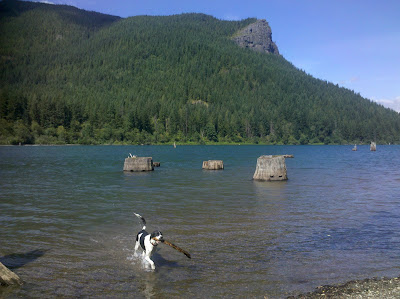Postcard from Rattlesnake Lake, south of North Bend, Washington
Moncton was a small railroad town built a half-day’s journey from Seattle to service trains before the climb east through the Cascade Mountains. It had a school and a store, and though it may have seemed to some people as being way out in the middle of a rainy forest, it was a nice place to raise kids and on sunny days the rocky outcrop above town provided great views.
Many Monctonites were a little sad when the City of Seattle started to build a large dam on the nearby Cedar River, changing the small town feel of the place. Built to create electricity and store drinking water, the dam accelerated years of development of an area previously known for timber and mining. But when water began to rise behind the dam, Moncton had greater things to worry about. The pond adjacent to town also started to grow, and in a short time it had flooded much of the village. No one had figured that holding water a mile and half away would result in seepage through porous soils, creating landslides (known as the Boxley Burst) and making Moncton uninhabitable. In the name of progress people moved on to nearby towns either up or down the line, or gave up all together and moved away.
Now, over 90 years later, the water still fluctuates in Rattlesnake Lake depending on the level of the reservoir, though it takes a couple of weeks to trickle down. It’s now a park and my family loves to swim and canoe there on hot summer days, jumping from half-submerged stumps of long-gone trees and listening for the voices of Moncton ghosts. The railroad line has given way to a trail for bikes and horses, and Rattlesnake Ledge is one of the busiest hiking trails in the state.
P.S. Contrary to the name, there are no rattlesnakes on the west side of the Cascades.

Bill Richards, http://www.familyontheloose.com/


















